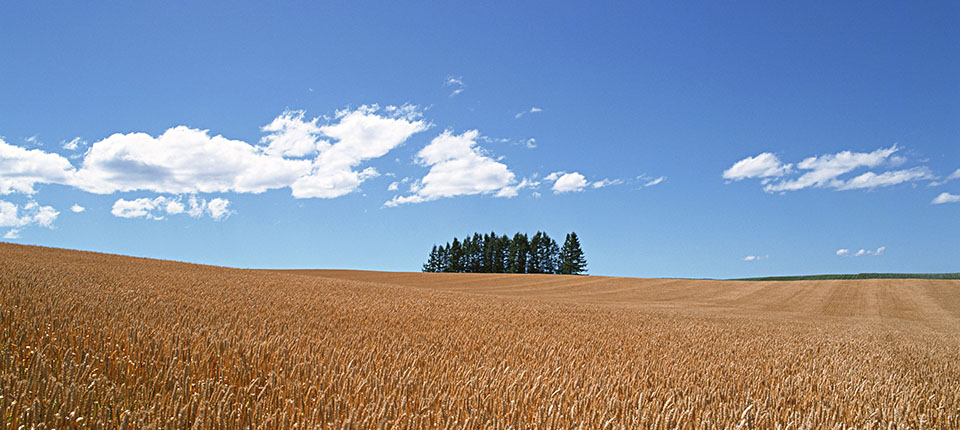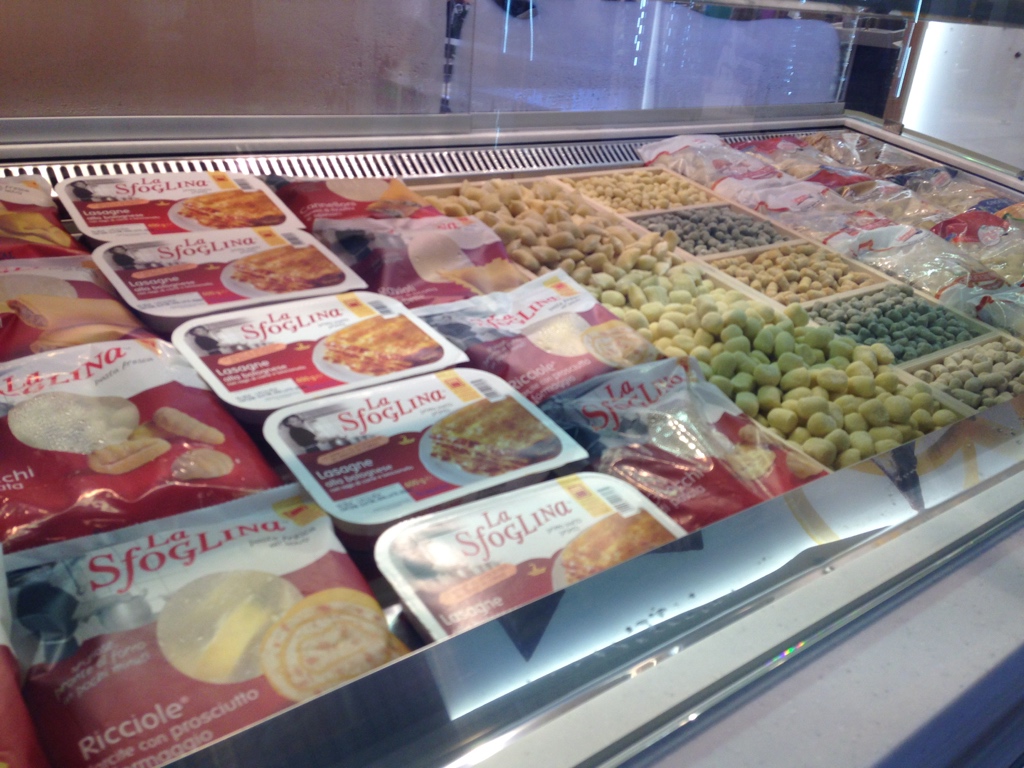
Geography of the durum wheat crop
14 December 2015Durum wheat is grown primarily in the Mediterranean basin, the northern plains of the United States and Canada, the desert areas of the southeast of the United States and north of Mexico and other lesser regions. We will be looking at the main quality characteristics of the varieties of durum wheat based on their area of origin, in relation to their use in producing dried pasta.
by Roberto Ranieri (Open Fields)
Durum wheat (Triticum turgidum var. durum Desf.) is a minor cereal crop. It represents just the 5% of the total wheat crop, which in the last three years has overcome the 700 million metric tons (MMT, see Table 1). Durum wheat is thought to have originated in present day Turkey, Syria, Iraq, and Iran. Durum wheat is an allotetraploid (two genomes: AABB) with a total of 28 chromosomes (2n=4x=28), containing the full diploid complement of chromosomes from each of its progenitor species.
Differently from common wheat, which is basically cropped everywhere in the world with the exception of the tropical areas, durum wheat is mainly cropped in 3 main basins: Mediterranean, Northern Plains between United States of America and Canada and within the desert areas of South West of United States and Northern Mexico. There are other much smaller areas where durum wheat is cultivated between Russia and Kazakhstan, Australia, India and Argentina (see Figure 1).
Mediterranean Basin
People living around the Mediterranean Sea are the major users of durum wheat: pasta, couscous, bulgur and bread are the major food products obtained from 4 completely different technologies. Industrial processes also exploit these technologies, coming from tradition, and today it is possible to find good industrial products beside the artisanal ones, although pasta, couscous, bulgur and bread are still made at home too.
The total production, under winter cycle, in the Mediterranean Basin varies significantly because the whole crop relies on rain. In Northern Africa and Southern Europe, the agronomic yields are highly influenced by drought; therefore, total production in one season can be around 14 MMT as for 2014/15 crop, or around 18 MMT as for this season (2015/16 crop), or almost 20 MMT as sometimes it occurred in the past (see Table 2). Nevertheless, the durum wheat need of the countries of the Mediterranean Basin is higher than what is guaranteed by local productions; so, every year, more than 5 MMT reach these countries, mostly coming from North America.
TAmong all the countries that appear on the Mediterranean Sea, Italy is the major durum wheat producer with almost 4.0 MMT in average. Turkey and France are the followers with average of 2.7 and 1.7 MMT, respectively. Generally, smaller productions are characterizing Morocco, Algeria, Tunisia, mainly due to the effect of the dry climate that often occurs during the crop cycle. The quality of these productions varies significantly due to the weather conditions as well as the final destination of the durum wheat. For couscous and bulgur the most important wheat characters are virtuousness and test weight while for pasta production are protein, gluten strength and color. Therefore, the local durum wheat productions as well as the exporters are paying attention to these quality targets. Generally, higher protein content wheat goes to Europe, where the pasta industry is the main user and durum wheat lots with higher virtuousness are reaching the North African countries. Currently, due to immigration to Europe and to the spreading of the pasta all over the world, increasing quantities of couscous are produced in Europe, and pasta is more and more produced in Northern Africa and in Tunisia. In Turkey, durum wheat is used both for bulgur and pasta production. Turkish pasta-making is becoming an important player in the pasta export towards middle east and African countries. The durum wheat varieties used in Turkey have local origins from old population cultivated in remote areas and international origins as from Italy and France or derived from CIMMYT germplasm (International Center for wheat and corn breeding). [hidepost]
French durum wheat is considered one of the best durum for pasta quality: protein content and color are generally good. The durum wheat varieties are coming from the French breeding companies and the commercial lots are very well managed from the agronomic and from the segregation point of view.
North African durum varieties are coming from local populations and mostly from varieties coming from the breeding activities originated from ICARDA (International Center for Agricultural Research in Dry Areas) and CIMMYT (International Center for wheat and corn breeding) germplasm.
Italy is the biggest pasta-maker in the world; thanks to the presence of Barilla, Pasta Zara, Divella, De Cecco, Pasta Garofalo and hundreds of medium and small enterprises, more than the 50% of the pasta yearly produced in Italy (3.2 MMT) is exported to Europe and to the rest of the world. The Italian model of pasta making, which is based on durum wheat, is also reinforced also thanks to the presence of related industrial sectors as for industrial line producers both for milling and for pasta making, for pasta dies and other related devices, for lines automation as well as for durum wheat varieties, which are cropped also outside Italy. Most of these varieties are coming from local breeding activities; breeders have to face different climatic conditions as for drought in Southern regions like Puglia and Sicily and for water richer fields in Central and Northern Italy.
North American Northern Plains
This territorial name refers to durum wheat cropping area that includes North Dakota and Montana from United States and Saskatchewan and Alberta from Canada. The total durum wheat production, under spring cycle, from this territory yearly ranges between 6.5 MMT and 8.0 MMT. This basin together with the durum from the desert basin (South West US and Mexico) are the main supplier of the countries that are around the Mediterranean sea, where people are heavy consumers of pasta, couscous, bulgur and bread made with durum wheat.
Canada is the biggest durum wheat producer worldwide and production yearly ranges between 4.5 to 6 MMT, depending on the weather condition occurring during the spring cycle (May-September). More than 80% of the durum is obtained out of Saskatchewan. Average yields are typical of short cycle wheat and it is just above 2 MT/ha; protein content is generally high as well as color. Gluten strength and the resistance to the Cadmium uptake are also good. The major crop risk is the Fusarium Head Blight (FHB); for example on 2014, it severely affected the crop. The vomitoxin was present in high concentration in some areas. Durum wheat varieties are locally bred by breeding companies and public institutions. The majority of the production is exported.
Northern Plains of the United States are producing similar kind of crop although gluten strength is generally lower as well as resistance to Cadmium uptake. FHB is the most threatening risk of that area. North Dakota has the majority of the durum wheat crop, although the crop is increasing its importance year after year in Montana, still less affected by FHB. Varieties of durum wheat are mostly deriving from the breeding activities of the North Dakota State University; few breeding companies are doing some activity too. Yields average are around 2 MT/ha.
Durum from the Desert
The most famous one is the Desert Durum™ obtained from South Arizona and South California. Production can range between 0.3 to 0.5 MMT. Irrigation always occurs many times during the cycle. It is considered by the pasta-makers the best durum wheat in the world because of protein content, gluten strength, color and test weight, but especially for its stability, both for quality and quantity point of view. Such kind of stability is particularly appreciated by industry. High cadmium uptake could be considered the major risk of this kind of crop. Sustainability could be also an issue because of the high inputs under which the plants are grown, starting with heavy irrigations and fertilizations. Yields range between 5 to 7 MT/ha. Most of the top pasta quality products are containing wheat that comes from South West US: it is very well known and worldwide exported. Private breeding companies are developing original varieties, which are mostly cultivated under pre-sowing cultivation contracts. The trading companies that are taking care of storage, commercialization and export are very much linked to the breeding companies. Breeding, pre-sowing cultivation contracts, storage, and marketing together have become a model adopted in other parts of the world to ensure the durum wheat crop.
The Mexican desert durum is progressively raising its importance in the international market because in the last twenty years Mexico has become the second durum wheat exporter in the durum wheat market. The Mexican durum “trigo cristalino” is also produced in two states: Baja California (Mexicali Valley) and Sonora (Yaqui and Mayo Valley). Irrigation always occurs during the durum wheat cycle. Test weight, low ashes, low moisture are the outstanding quality parameters. Low protein sometimes is a barrier for pasta-making. Average yields ranges between 5.0 to 7.0 MT/ha. The durum wheat coming from the Sonora areas is also under quarantine restrictions in the other North American countries as well as in Europe because of the presence of the Karnal bunt kernel disease (Tilletia indica Mitra). Total production ranges between 1.0 to 2.3 MMT. Almost 1 MMT is yearly exported. The durum wheat varieties are very good adapted, particularly those cropped in the Sonora desert: it is one of the few places in the world, where durum wheat yields more than common/bread wheat (T. aestivum L.). This effect might be facilitated by the presence of the CIMMYT breeding station in Ciudad the Obregon (Sonora) that is leading one of the biggest durum wheat-breeding project in the world taking advantage also of the local authorities as Patronato and INIFAP.
Southern hemisphere durum
Australian durum wheat yearly production is around 0.5 MMT. It comes mostly from the New South Wales and from South Australia states. Protein content is high as well as color and test weight and ashes content. Yields range between 1.4 to 2.5 MT/ha. Local utilization is approximately of 0.25 MMT; the rest is exported. Main weakness of Australian durum is the price; for this reason most of the exported durum is high quality wheat. Durum wheat production is flat although they often declare that there are projects to increase durum wheat availability in Australia for export. New varieties have been released recently.
Argentinean durum (“candeal”) is limited to the local uses that are approximately around 0.25 MMT per year. In the late ‘70s Argentinean durum was considered the highest quality durum available in the international market and it was very popular among the Italian pasta-making industry. In some years, the exports reached 0.75 MMT. However, after a couple of years of bad quality wheat due to FHB attacks, the interest of the importers disappeared and the production was confined to the south of the Buenos Aires province. Currently, varieties are coming both from a public institute and from breeding companies. Non-vitreous kernels and FHB could represent the weaknesses of this crop.
Asian Durum: Indian, Kazakhstan and Russian durum
In India durum wheat crop is mostly cultivated in Punjab, where many wheat mills are concentrated and the main use is for chapati; Durum wheat is also cultivated in Madhya Pradesh and in Gujarat. In these states, durum crop can receive supplemental irrigation. Total production is generally above 1.0 MMT and sporadically only few boats are exported. Local varieties are cropped, mostly derived from the CIMMYT germplasm.
The durum wheat cultivated in Kazakhstan and in Russia, comes from neighboring regions: Altai region in Russia and Kostanai in Kazakhstan. Yields are generally below 1.0 MMT and the use is mostly to feed the Russian pasta-making industry needs. International statistics report that the durum wheat production is 2.5 MMT, but this is not proven by the value chain and local market. Local operators are saying that a reasonable quantity is less than 0.5 MMT.
Other countries and conclusions
Durum wheat is cultivated in many other countries; mostly as new crop, farmers are trying to cultivate it because of the price (generally 20% higher than the price of common wheat) and because of the need to rotate. Often, these attempts are not successful because the crop is treated as a common wheat crop, but the species are different and agronomy management is different as well. Often after having produced it, the commercialization is very difficult because the utilization is not widely spread as for common/bread wheat. In addition, breeding was not diffused as it was for common/bread wheat. Therefore, with only one exception (Mexico), the durum wheat is always less productive than common/bread wheat.
There are attempts of cultivation in Eastern Europe (Austria, Czech Republic, Hungary, Romania, Bulgaria…), in other States of the United States (Idaho, Nebraska…). There are also programs to enlarge the production in Argentina, Australia, and Ethiopia. Nevertheless, every year, the durum wheat production worldwide is around 35 MMT. While the common/bread wheat production has increased, the durum wheat production has not. The main effect of this is the high volatility of prices due to big variations in quantity and qualities.
[/hidepost]
Keep reading, download the magazine (it’s free)
 PASTARIA DE (digital edition) 2015 n. 6 (ITALIANO) (11.9 MiB, 1,335 download)
PASTARIA DE (digital edition) 2015 n. 6 (ITALIANO) (11.9 MiB, 1,335 download)
Registrazione necessaria. Sign-up to download. PASTARIA INTERNATIONAL DE (digital edition) 2015 no. 6 (ENGLISH) (17.0 MiB, 855 download)
PASTARIA INTERNATIONAL DE (digital edition) 2015 no. 6 (ENGLISH) (17.0 MiB, 855 download)
Registrazione necessaria. Sign-up to download.


